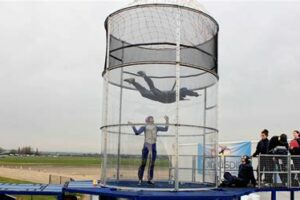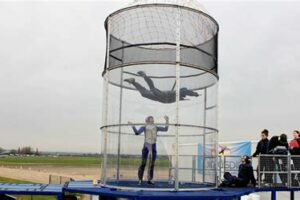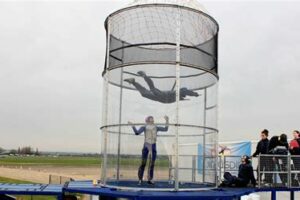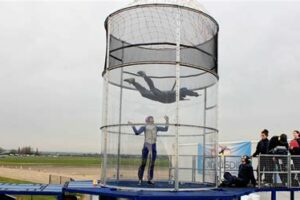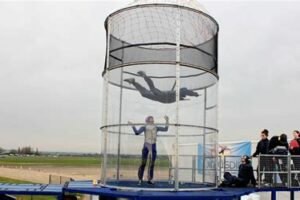Table of Contents
Indoor skydiving rules are crucial for ensuring safety and maximizing enjoyment. This guide provides a concise overview of the key regulations and guidelines that participants must adhere to, including proper attire, age restrictions, and basic body positions. Stay informed and prepared to experience the exhilarating thrill of indoor skydiving within a controlled environment.
Indoor skydiving, an exhilarating sport that allows participants to experience the thrill of freefalling in a controlled environment, comes with its own set of rules and regulations. Whether you are a seasoned skydiver or a first-timer, following these guidelines ensures a safe and enjoyable experience. So, buckle up your harness and get ready to defy gravity as we take you through the essential indoor skydiving rules that will keep you flying high.
Introduction
Welcome to the exciting world of indoor skydiving! Whether you are a beginner or an experienced flyer, it is essential to familiarize yourself with the rules and regulations in place for your safety and the safety of others. In this article, we will guide you through the instructions and guidelines that you need to follow while indulging in this thrilling adventure.
Dress Code and Safety Gear
Flyer Attire
When participating in indoor skydiving, it is important to wear comfortable clothing that allows for easy movement. Avoid loose-fitting items or accessories that could potentially become entangled during the flight. Additionally, remove any sharp objects such as jewelry or belts that might pose a risk.
Safety Gear
Prior to your flight, you will be provided with a jumpsuit, helmet, goggles, and earplugs. Ensure that these items fit you properly and snugly. The jumpsuit will help maintain stability during the flight, while the helmet, goggles, and earplugs protect your head, eyes, and ears from any potential hazards.
Pre-Flight Instructions
Training Session
Prior to entering the wind tunnel, you will receive a comprehensive training session from a certified instructor. Pay close attention and follow their instructions carefully. They will guide you on body positioning, hand signals, and safety protocols to ensure a safe and enjoyable experience.
Physical Restrictions
Inform your instructor of any physical restrictions or medical conditions that may affect your ability to fly. Certain health conditions, such as heart problems or back injuries, may require special attention or even prohibit participation in indoor skydiving. Safety should always be the top priority.
In-Flight Etiquette
Respect the Instructor
During the flight, it is important to respect your instructor’s guidance and follow their directions at all times. They are there to ensure your safety and maximize your enjoyment. Avoid any sudden or unnecessary movements that may compromise your stability or disrupt the flow of the session.
Flying within Your Limits
Stay within your skill level and comfort zone. Attempting advanced maneuvers without proper training can lead to accidents or injuries. As you gain more experience, you can gradually explore new techniques under the guidance of a qualified instructor.
Emergency Procedures
Emergency Signal
If you encounter any difficulties during the flight or need immediate assistance, use the pre-established emergency signal. Typically, this involves crossing your arms over your chest and maintaining eye contact with the instructor. They will respond promptly to ensure your safety.
Exiting the Wind Tunnel
Once your flight is complete, your instructor will guide you on the proper procedure to exit the wind tunnel safely. Follow their instructions carefully to avoid any accidents or collisions with other flyers. Remember to express your appreciation for the experience and thank your instructor for their guidance.
Conclusion
Indoor skydiving offers a thrilling adventure in a controlled environment, but it is crucial to adhere to the rules and guidelines to ensure a safe and enjoyable experience. By following the dress code, paying attention to pre-flight instructions, exhibiting proper in-flight etiquette, and being aware of emergency procedures, you can make the most of your indoor skydiving journey. So gear up, take a leap, and enjoy the incredible sensation of flying!
Safety First
Before engaging in indoor skydiving, it is crucial to prioritize your safety. Firstly, ensure that you are in good health and do not have any pre-existing medical conditions that could pose a risk during the activity. Attending the safety briefing provided by our experienced instructors is essential to familiarize yourself with the rules and procedures. Always follow the guidelines given by your instructor and the facility to ensure a safe and enjoyable experience.
Appropriate Attire
Choosing the right attire for indoor skydiving is vital for your safety and comfort. It is recommended to wear comfortable clothing and closed-toe shoes that fit well. Loose items can pose a hazard if they fall into the wind tunnel, so avoid wearing loose jewelry or accessories. Additionally, tie back long hair and remove any items from your pockets to prevent injury and avoid damaging the equipment.
Body Positioning
Proper body positioning is key to stabilize yourself and make the most of your indoor skydiving experience. Throughout the flight, maintain a relaxed body posture with a slight arch in your back. This position will help you achieve optimal flying posture. Listen carefully to your instructor’s guidance to ensure proper body alignment and posture, guaranteeing a safe and controlled flight.
Communication Signals
During your indoor skydiving session, your instructor will use hand signals to communicate with you. These signals will indicate when to adjust your body position, stop or start spinning, or land safely. It is crucial to familiarize yourself with these signals and pay close attention to them. Promptly following these signals will facilitate seamless communication between you and your instructor, ensuring a smooth and enjoyable flight.
Respecting Personal Space
Indoor skydiving is a shared experience, and it is essential to respect the personal space of others in the wind tunnel. To avoid collisions or accidents, maintain a safe distance from other flyers. Stay within your designated flying area and avoid crossing into other flyers’ zones. If you are flying with others, be sure to follow the instructions given by the instructor regarding positioning and spacing, guaranteeing the safety of everyone involved.
Health and Safety Guidelines
While indoor skydiving is an exhilarating activity, it may not be suitable for individuals with certain health conditions. If you have heart problems, high blood pressure, or back injuries, it is important to consult with your doctor before attempting indoor skydiving. It is crucial to disclose any medical conditions or limitations to the instructor before your flight. This way, proper precautions can be taken to ensure your safety and well-being throughout the experience.
Weather Conditions
One of the advantages of indoor skydiving is that it is not affected by weather conditions, allowing you to enjoy this activity all year round. Unlike traditional skydiving, which relies heavily on favorable weather conditions, indoor skydiving provides a consistent and controlled environment. However, it is still important to be aware of any facility-specific guidelines or rules related to weather or technical issues. These guidelines may affect the availability of the experience, so make sure to stay informed.
Follow Facility Rules
To ensure a safe and pleasant experience for everyone, it is crucial to abide by all facility rules and regulations during your visit. This includes following the instructions provided by the staff, adhering to any age or weight restrictions, and complying with any additional safety procedures. Failure to follow the facility’s rules may result in the cancellation of your flight or pose potential risks to yourself and others. By respecting and adhering to these rules, you contribute to a safe and enjoyable environment for all participants.
Indoor skydiving is an exhilarating activity that allows individuals to experience the thrill of freefall in a controlled indoor environment. To ensure the safety and enjoyment of all participants, it is important to adhere to the following rules and instructions:
-
Arrival and preparation:
- Arrive at least 30 minutes prior to your scheduled flight time.
- Check-in at the front desk and complete any necessary paperwork.
- Receive a safety briefing from a qualified instructor.
- Put on the provided jumpsuit, helmet, goggles, and earplugs.
-
Body positioning:
- Keep your body relaxed and maintain a neutral position during flight.
- Arch your back slightly and extend your arms forward for stability.
- Avoid flailing or excessive movement, as it can disrupt your balance.
- Listen to your instructor’s guidance and make adjustments accordingly.
-
Communication:
- Use hand signals to communicate with your instructor while inside the wind tunnel.
- Thumbs up means I’m ready, thumbs down means stop, and a flat hand indicates neutral.
- If you have any concerns or questions, let your instructor know immediately.
-
Safety precautions:
- Do not wear loose jewelry, watches, or accessories that could get caught in the wind tunnel.
- Remove any sharp objects or items from your pockets.
- Secure long hair and tie it back to prevent interference with the airflow.
- Follow all instructions given by the instructor regarding entry and exit from the wind tunnel.
-
Enjoyment and respect:
- Have fun and enjoy the unique experience of indoor skydiving!
- Respect the facility’s rules and guidelines at all times.
- Be mindful of other participants and maintain a safe distance from them.
- Listen attentively to your instructor and follow their guidance for an optimal flight experience.
By following these rules and instructions, you can have a safe and unforgettable indoor skydiving experience. Remember to always prioritize safety and listen to your instructor for an enjoyable flight!
Thank you for visiting our blog and taking the time to read about indoor skydiving rules. We hope that the information we have provided has been helpful and informative. Before you take to the skies and experience the exhilarating thrill of indoor skydiving, it is important to familiarize yourself with the rules and regulations to ensure a safe and enjoyable experience.
First and foremost, it is essential to listen carefully to the instructions provided by the trained professionals at the indoor skydiving facility. They will guide you through the entire process, from suiting up in the appropriate gear to executing the proper body positions during your flight. Pay close attention to their advice and ask any questions you may have to clarify any doubts or concerns.
When it comes to body positioning, maintaining the correct posture is crucial for a successful indoor skydiving experience. Your instructor will demonstrate the proper body position, which involves keeping your chin up, arms slightly bent, and legs straight. Remember to relax your body and avoid tensing up as this can hinder your ability to maneuver and stay stable in the wind tunnel.
Additionally, it is important to dress appropriately for indoor skydiving. Wear comfortable clothing that allows for freedom of movement, such as athletic wear or loose-fitting clothes. Avoid wearing any accessories, such as jewelry or watches, that could become loose or pose a risk during the flight. It is also recommended to tie back long hair and remove any sharp objects or items from your pockets.
Lastly, be aware of any health or physical restrictions that may prevent you from participating in indoor skydiving. While it is generally a safe activity for people of various fitness levels, certain medical conditions or injuries may require you to refrain from participating. It is always best to consult with your physician beforehand if you have any concerns or doubts about your suitability for indoor skydiving.
In conclusion, we hope that you have gained valuable insights into the indoor skydiving rules through this blog. Remember to listen to the instructions provided by the professionals, maintain proper body positioning, dress appropriately, and be aware of any health restrictions. By adhering to these guidelines, you can ensure a safe, thrilling, and unforgettable indoor skydiving experience. So, what are you waiting for? Take the plunge and enjoy the incredible sensation of freefalling in a controlled and secure environment!
Video Indoor Skydiving Rules
Here are some common questions people also ask about indoor skydiving rules:
1. What are the age and weight restrictions for indoor skydiving? – Age restrictions vary by facility, but most indoor skydiving centers require participants to be at least 3 years old. However, individuals under 18 usually need parental consent or presence. Weight restrictions typically range from 250 to 300 pounds to ensure safety during flight.2. Do I need any prior experience or training to go indoor skydiving? – No prior experience or training is necessary for indoor skydiving. Professional instructors will provide you with a comprehensive briefing before your flight. They will teach you the basic techniques, safety procedures, and hand signals to ensure a safe and enjoyable experience.3. What should I wear for indoor skydiving? – It is recommended to wear comfortable clothing such as a t-shirt, shorts, and socks. Avoid wearing loose accessories like jewelry, scarves, or hats that could fly off during the flight. Additionally, remove any sharp objects from your pockets to prevent injury.4. Are there any health conditions that may restrict me from indoor skydiving? – Some health conditions may prevent individuals from participating in indoor skydiving. These conditions can include heart problems, back or neck injuries, shoulder dislocations, pregnancy, and recent surgeries. It is advisable to consult your doctor if you have any concerns about your health and ability to participate.5. What safety measures are in place during indoor skydiving? – Indoor skydiving facilities prioritize safety and employ various measures to ensure a secure environment. These can include well-maintained wind tunnels, professional instructors, safety briefings, and the use of flight suits, helmets, goggles, and earplugs. Instructors will closely supervise your flight and provide guidance throughout.Remember, it is always best to check with your specific indoor skydiving facility for their rules and guidelines as they may differ slightly.

